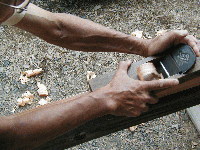Wood processing
Among wood processing refers to the manufacturing and handling of work pieces made of wood with tools, some of which go directly as goods in use, partly as components with predetermined geometric determinants (subject to certain tolerances and surface finishes ) to be mounted in other goods into functional products. Wood processing is a sub-area of manufacturing technology .
Wood processing is carried out in a wide variety of branches of industry and craft, e.g. B. in jewelry production , tool and mold making to vehicle construction , mechanical engineering , shipbuilding and bridge construction .
A distinction is made between machining and non-machining processes in wood processing. Many professions have developed around wood processing (e.g. carpenter , carpenter , wood turner ). In most non-cutting machining processes - in addition to steaming ( Thonet ) - glue plays a particularly important role.
History of wood processing

Since wood is a common and easy to work material, woodworking is almost as old as mankind. Tools for working with wood (e.g. drills , scrapers , hatchets , adzes , axes , chisels and splitting wedges ) have been known since the Neolithic and have been documented by finds. Initially only branches are likely to have been processed (e.g. for weapons such as sticks , clubs , spears , spears and throwers ). Later, little processed round logs were used as lever bars, supports, rollers, etc.; A later phase comes from dugouts , log houses , etc. Even later, hewn beams were made that were used as door frames , lintels or in half-timbered buildings . The production of cut boards (e.g. in shipbuilding , for doors and for furniture , etc.) probably belongs to the late phase of early woodworking.
The saws as a production method is also known from very early times. The Egyptians used hacksaws made of bronze as early as the Bronze Age , and the first inlays can also be found in them . This fine art of surface treatment later came to a standstill in Europe during the Middle Ages . The plane as a typical tool for woodworking can be traced back to Roman times ; In 1991, two planes from the Roman era were found in Üttfeld / Eifel, the construction and function of which seems quite modern.
The first machine processing of wood, turning, can already be traced back to the first high cultures. Fiddle bits and files or rasp complete the prehistoric woodworking inventory. Tree resins were probably used as the first glue. Knowledge of metalworking allowed these tools to be refined and improved, but today's woodworking processes can in principle still be traced back to these basic processes.
Tools
Wood is usually machined, as it is fibrous and easily splinters, a very sharp cutting edge is required. The great elasticity of the wood means that the part of the wood pressed away by the tool and thus not removed as chips strives for its original shape again. This can lead to dangerous accidents with circular saws , which is why a wedge behind the circular saw blade and a cover are mandatory to prevent jamming and / or kickback of the sawed material.
Terms / distinctions

- Hand-held tools that (with palms , knock wood or Knüpfel ) are beaten, is called gouge
- Hand-held tools that are pushed or pushed are called burins
- Hand-held tools are the pushed or pulled scraper , scraping and planing
- A hatchet is a parallel tool, and an adze is a cross tool with a handle and a cutting blade
- Knives are all tools that have their cutting edge on the long edge
- Milling cutters are multi-edged tools with the cutting edges on the front or long side
- Drills are multi-edged tools for axial feed
- Saws are multi-edged tools with teeth on their long side
- Files and rasps are multi-edged tools with teeth on their surface
- Wedges are auxiliary tools for pressing the wood apart
- Clamps are auxiliary tools for pressing the wood together
Drives for wood drilling machines
- Lever - on the earliest drilling machines, it was often just a cross piece
- Bow - a bow, the string of which is once wrapped around the drill, allows relatively high speeds to be achieved
- Crank - already known to the Egyptians as a drill winch
- Gear drill bits from around the 19th century
- Electric motor - electric hand drill 1895 (Fein)
See also
- Wood technology - processing of wood and materials made of wood (such as chipboard, etc.)
literature
- Edgar Finsterbusch, Werner Thiele: From stone ax to saw gate. A journey through the history of woodworking . Leipzig 1983.


